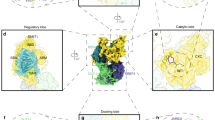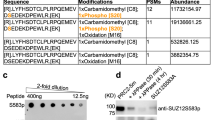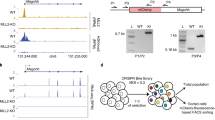Abstract
Polycomb-group proteins are transcriptional repressors with essential roles in embryonic development. Polycomb repressive complex 2 (PRC2) contains the methyltransferase activity for Lys27. However, the role of other histone modifications in regulating PRC2 activity is just beginning to be understood. Here we show that direct recognition of methylated histone H3 Lys36 (H3K36me), a mark associated with activation, by the PRC2 subunit Phf19 is required for the full enzymatic activity of the PRC2 complex. Using NMR spectroscopy, we provide structural evidence for this interaction. Furthermore, we show that Phf19 binds to a subset of PRC2 targets in mouse embryonic stem cells and that this is required for their repression and for H3K27me3 deposition. These findings show that the interaction of Phf19 with H3K36me2 and H3K36me3 is essential for PRC2 complex activity and for proper regulation of gene repression in embryonic stem cells.
This is a preview of subscription content, access via your institution
Access options
Subscribe to this journal
Receive 12 print issues and online access
$189.00 per year
only $15.75 per issue
Buy this article
- Purchase on Springer Link
- Instant access to full article PDF
Prices may be subject to local taxes which are calculated during checkout







Similar content being viewed by others
References
Sparmann, A. & van Lohuizen, M. Polycomb silencers control cell fate, development and cancer. Nat. Rev. Cancer 6, 846–856 (2006).
Schwartz, Y.B. & Pirrotta, V. Polycomb silencing mechanisms and the management of genomic programmes. Nat. Rev. Genet. 8, 9–22 (2007).
Bracken, A.P., Dietrich, N., Pasini, D., Hansen, K.H. & Helin, K. Genome-wide mapping of Polycomb target genes unravels their roles in cell fate transitions. Genes Dev. 20, 1123–1136 (2006).
Boyer, L.A. et al. Polycomb complexes repress developmental regulators in murine embryonic stem cells. Nature 441, 349–353 (2006).
O'Carroll, D. et al. The polycomb-group gene Ezh2 is required for early mouse development. Mol. Cell. Biol. 21, 4330–4336 (2001).
Surface, L.E., Thornton, S.R. & Boyer, L.A. Polycomb group proteins set the stage for early lineage commitment. Cell Stem Cell 7, 288–298 (2010).
Sauvageau, M. & Sauvageau, G. Polycomb group proteins: multi-faceted regulators of somatic stem cells and cancer. Cell Stem Cell 7, 299–313 (2010).
Schmitges, F.W. et al. Histone methylation by PRC2 is inhibited by active chromatin marks. Mol. Cell 42, 330–341 (2011).
Morey, L. et al. Nonoverlapping functions of the Polycomb group Cbx family of proteins in embryonic stem cells. Cell Stem Cell 10, 47–62 (2012).
Sing, A. et al. A vertebrate Polycomb response element governs segmentation of the posterior hindbrain. Cell 138, 885–897 (2009).
Woo, C.J., Kharchenko, P.V., Daheron, L., Park, P.J. & Kingston, R.E. A region of the human HOXD cluster that confers polycomb-group responsiveness. Cell 140, 99–110 (2010).
Mendenhall, E.M. et al. GC-rich sequence elements recruit PRC2 in mammalian ES cells. PLoS Genet. 6, e1001244 (2010).
Richly, H. et al. Transcriptional activation of polycomb-repressed genes by ZRF1. Nature 468, 1124–1128 (2010).
Landeira, D. et al. Jarid2 is a PRC2 component in embryonic stem cells required for multi-lineage differentiation and recruitment of PRC1 and RNA Polymerase II to developmental regulators. Nat. Cell Biol. 12, 618–624 (2010).
Pasini, D. et al. JARID2 regulates binding of the Polycomb repressive complex 2 to target genes in ES cells. Nature 464, 306–310 (2010).
Peng, J.C. et al. Jarid2/Jumonji coordinates control of PRC2 enzymatic activity and target gene occupancy in pluripotent cells. Cell 139, 1290–1302 (2009).
Shen, X. et al. Jumonji modulates polycomb activity and self-renewal versus differentiation of stem cells. Cell 139, 1303–1314 (2009).
Nekrasov, M. et al. Pcl-PRC2 is needed to generate high levels of H3–K27 trimethylation at Polycomb target genes. EMBO J. 26, 4078–4088 (2007).
Savla, U., Benes, J., Zhang, J. & Jones, R.S. Recruitment of Drosophila Polycomb-group proteins by Polycomblike, a component of a novel protein complex in larvae. Development 135, 813–817 (2008).
Casanova, M. et al. Polycomblike 2 facilitates the recruitment of PRC2 Polycomb group complexes to the inactive X chromosome and to target loci in embryonic stem cells. Development 138, 1471–1482 (2011).
Walker, E. et al. Polycomb-like 2 associates with PRC2 and regulates transcriptional networks during mouse embryonic stem cell self-renewal and differentiation. Cell Stem Cell 6, 153–166 (2010).
Cao, R. et al. Role of hPHF1 in H3K27 methylation and Hox gene silencing. Mol. Cell. Biol. 28, 1862–1872 (2008).
Sarma, K., Margueron, R., Ivanov, A., Pirrotta, V. & Reinberg, D. Ezh2 requires PHF1 to efficiently catalyze H3 lysine 27 trimethylation in vivo. Mol. Cell. Biol. 28, 2718–2731 (2008).
Koh, A.S. et al. Aire employs a histone-binding module to mediate immunological tolerance, linking chromatin regulation with organ-specific autoimmunity. Proc. Natl. Acad. Sci. USA 105, 15878–15883 (2008).
McGuffin, L.J., Bryson, K. & Jones, D.T. The PSIPRED protein structure prediction server. Bioinformatics 16, 404–405 (2000).
Eissenberg, J.C. Structural biology of the chromodomain: form and function. Gene 496, 69–78 (2012).
Bua, D.J. et al. Epigenome microarray platform for proteome-wide dissection of chromatin-signaling networks. PLoS ONE 4, e6789 (2009).
Friberg, A., Oddone, A., Klymenko, T., Müller, J. & Sattler, M. Structure of an atypical Tudor domain in the Drosophila Polycomblike protein. Protein Sci. 19, 1906–1916 (2010).
Lee, J., Thompson, J.R., Botuyan, M.V. & Mer, G. Distinct binding modes specify the recognition of methylated histones H3K4 and H4K20 by JMJD2A-Tudor. Nat. Struct. Mol. Biol. 15, 109–111 (2008).
Botuyan, M.V. et al. Structural basis for the methylation state-specific recognition of histone H4–K20 by 53BP1 and Crb2 in DNA repair. Cell 127, 1361–1373 (2006).
Huang, Y., Fang, J., Bedford, M.T., Zhang, Y. & Xu, R.M. Recognition of histone H3 lysine-4 methylation by the double Tudor domain of JMJD2A. Science 312, 748–751 (2006).
Flanagan, J.F. et al. Double chromodomains cooperate to recognize the methylated histone H3 tail. Nature 438, 1181–1185 (2005).
Jacobs, S.A. & Khorasanizadeh, S. Structure of HP1 chromodomain bound to a lysine 9-methylated histone H3 tail. Science 295, 2080–2083 (2002).
Nielsen, P.R. et al. Structure of the HP1 chromodomain bound to histone H3 methylated at lysine 9. Nature 416, 103–107 (2002).
Peña, P.V. et al. Molecular mechanism of histone H3K4me3 recognition by plant homeodomain of ING2. Nature 442, 100–103 (2006).
Li, H. et al. Molecular basis for site-specific read-out of histone H3K4me3 by the BPTF PHD finger of NURF. Nature 442, 91–95 (2006).
Vezzoli, A. et al. Molecular basis of histone H3K36me3 recognition by the PWWP domain of Brpf1. Nat. Struct. Mol. Biol. 17, 617–619 (2010).
Margueron, R. et al. Role of the polycomb protein EED in the propagation of repressive histone marks. Nature 461, 762–767 (2009).
Pasini, D., Bracken, A.P., Jensen, M.R., Lazzerini Denchi, E. & Helin, K. Suz12 is essential for mouse development and for EZH2 histone methyltransferase activity. EMBO J. 23, 4061–4071 (2004).
Li, G. et al. Jarid2 and PRC2, partners in regulating gene expression. Genes Dev. 24, 368–380 (2010).
Yuan, W. et al. H3K36 methylation antagonizes PRC2-mediated H3K27 methylation. J. Biol. Chem. 286, 7983–7989 (2011).
Cloos, P.A., Christensen, J., Agger, K. & Helin, K. Erasing the methyl mark: histone demethylases at the center of cellular differentiation and disease. Genes Dev. 22, 1115–1140 (2008).
Wagner, E.J. & Carpenter, P.B. Understanding the language of Lys36 methylation at histone H3. Nat. Rev. Mol. Cell Biol. 13, 115–126 (2012).
Sun, B. et al. Molecular basis of the interaction of Saccharomyces cerevisiae Eaf3 chromo domain with methylated H3K36. J. Biol. Chem. 283, 36504–36512 (2008).
Sánchez, C. et al. Proteomics analysis of Ring1B/Rnf2 interactors identifies a novel complex with the Fbxl10/Jhdm1B histone demethylase and the Bcl6 interacting corepressor. Mol. Cell. Proteomics 6, 820–834 (2007).
He, J., Kallin, E.M., Tsukada, Y. & Zhang, Y. The H3K36 demethylase Jhdm1b/Kdm2b regulates cell proliferation and senescence through p15nk4b. Nat. Struct. Mol. Biol. 15, 1169–1175 (2008).
He, J., Nguyen, A.T. & Zhang, Y. KDM2b/JHDM1b, an H3K36me2-specific demethylase, is required for initiation and maintenance of acute myeloid leukemia. Blood 117, 3869–3880 (2011).
Liang, G., He, J. & Zhang, Y. Kdm2b promotes induced pluripotent stem cell generation by facilitating gene activation early in reprogramming. Nat. Cell Biol. 14, 457–466 (2012).
Lange, M. et al. Regulation of muscle development by DPF3, a novel histone acetylation and methylation reader of the BAF chromatin remodeling complex. Genes Dev. 22, 2370–2384 (2008).
Grzesiek, S. & Bax, A. Improved 3D triple-resonance NMR techniques applied to a 31-kDa protein. J. Magn. Reson. 96, 432–440 (1992).
Kay, L.E., Xu, G.Y., Singer, A.U., Muhandiram, D.R. & Formankay, J.D. A gradient-enhanced HCCH-TOCSY experiment for recording side-chain H-1 and C-13 correlations in H2O samples of proteins. J. Magn. Reson. B 101, 333–337 (1993).
Schleucher, J., Sattler, M. & Griesinger, C. Coherence selection by gradients without signal attenuation – application to the 3-dimensional HNCO experiment. Angew. Chem. 32, 1489–1491 (1993).
Wittekind, M. & Mueller, L. HNCACB, a high-sensitivity 3D NMR experiment to correlate amide proton and nitrogen resonances with the alpha-carbon and beta-carbon resonances in proteins. J. Magn. Reson. B 101, 201–205 (1993).
Muhandiram, D.R. & Kay, L.E. Gradient-enhanced triple-resonance 3-dimensional NMR experiments with improved sensitivity. J. Magn. Reson. B 103, 203–216 (1994).
Yamazaki, T., Lee, W., Arrowsmith, C.H., Muhandiram, D.R. & Kay, L.E. A suite of triple-resonance NMR experiments for the backbone assignment of N-15, C-13, H-2 labeled proteins with high sensitivity. J. Am. Chem. Soc. 116, 11655–11666 (1994).
Grzesiek, S., Anglister, J. & Bax, A. Correlation of backbone amides and aliphatic side-chain resonances in C-13/N-15-enriched proteins by isotropic mixing of C-13 magnetization. J. Magn. Reson. B 101, 114–119 (1993).
Montelione, G.T., Lyons, B.A., Emerson, S.D. & Tashiro, M. An efficient triple resonance experiment using C-13 isotropic mixing for determining sequence-specific resonance assignments of isotopically enriched proteins. J. Am. Chem. Soc. 114, 10974–10975 (1992).
Yamazaki, T., Forman-Kay, J.D. & Kay, L.E. 2-dimensional NMR experiments for correlating C-13-beta and H-1-delta/epsilon chemical shifts of aromatic residues in C-13-labeled proteins via scalar couplings. J. Am. Chem. Soc. 115, 11054–11055 (1993).
Zwahlen, C. et al. Methods for measurement of intermolecular NOEs by multinuclear NMR spectroscopy: Application to a bacteriophage lambda N-peptide/boxB RNA complex. J. Am. Chem. Soc. 119, 6711–6721 (1997).
Wishart, D.S. & Sykes, B.D. The C-13 chemical shift index - a simple method for the identification of protein secondary structure using C-13 chemical shift data. J. Biomol. NMR 4, 171–180 (1994).
Delaglio, F. et al. NMRPIPE—A multidimensional spectral processing system based on UNIX pipes. J. Biomol. NMR 6, 277–293 (1995).
Johnson, B.A. & Blevins, R.A. NMR VIEW – A computer program for the visualization and analysis of NMR data. J. Biomol. NMR 4, 603–614 (1994).
Linge, J.P., Habeck, M., Rieping, W. & Nilges, M. ARIA: automated NOE assignment and NMR structure calculation. Bioinformatics 19, 315–316 (2003).
Nederveen, A.J. et al. RECOORD: a recalculated coordinate database of 500+ proteins from the PDB using restraints from the BioMagResBank. Proteins 59, 662–672 (2005).
Bernard, A., Vranken, W.F., Bardiaux, B., Nilges, M. & Malliavin, T.E. Bayesian estimation of NMR restraint potential and weight: a validation on a representative set of protein structures. Proteins 79, 1525–1537 (2011).
Linge, J.P. & Nilges, M. Influence of non-bonded parameters on the quality of NMR structures: A new force field for NMR structure calculation. J. Biomol. NMR 13, 51–59 (1999).
Cornilescu, G., Delaglio, F. & Bax, A. Protein backbone angle restraints from searching a database for chemical shift and sequence homology. J. Biomol. NMR 13, 289–302 (1999).
Linge, J.P., Williams, M.A., Spronk, C., Bonvin, A. & Nilges, M. Refinement of protein structures in explicit solvent. Proteins 50, 496–506 (2003).
Nozinovic, S., Furtig, B., Jonker, H.R.A., Richter, C. & Schwalbe, H. High-resolution NMR structure of an RNA model system: the 14-mer cUUCGg tetraloop hairpin RNA. Nucleic Acids Res. 38, 683–694 (2010).
Laskowski, R.A., Macarthur, M.W., Moss, D.S. & Thornton, J.M. PROCHECK—A program to check the stereochemical quality of protein structures. J. Appl. Crystallogr. 26, 283–291 (1993).
Vriend, G. WHAT IF: a molecular modeling and drug design program. J. Mol. Graph. 8, 52–56, 29 (1990).
Acknowledgements
We thank V.A. Raker for help in manuscript preparation, D. Patel, G. Castellano, A. Ladurner and members of the Di Croce laboratory for discussions, and the Centre for Genomic Regulation (CRG) Genomic, Bioinformatic and Proteomic Units. Peptides for NMR studies were supplied by R. Pipkorn, DKFZ (German Cancer Research Center). This work was supported by grants from the Spanish 'Ministerio de Educación y Ciencia' (BFU2010-18692), from AGAUR (Agency for Administration of University and Research Grants), from the European Commission's 7th Framework Program 4DCellFate grant number 277899 to L.D.C. and from the US National Institutes of Health (NCI118487 and GM071004) to Y.S. M.L. was supported by a Juan de la Cierva fellowship, R.L. was supported by a research fellowship from the German research foundation (DFG, LI 2057/1-1), and L.M. was supported by a postdoctoral CRG-Novartis fellowship. T.C., B.S. and A.L. were supported by the European Molecular Biology Laboratory.
Author information
Authors and Affiliations
Contributions
C.B., M.L., A.L., G.M.M., L.M., G.P., R.L., B.S., Y.S., O.G., T.C., S.A.B. and L.D.C. designed, executed and analyzed the experiments. C.B., M.L., O.G., T.C., S.A.B. and L.D.C. wrote the manuscript.
Corresponding author
Ethics declarations
Competing interests
The authors declare no competing financial interests.
Supplementary information
Supplementary Text and Figures
Supplementary Figures 1–7, Supplementary Table 3 and Supplementary Note (PDF 6534 kb)
Supplementary Table 1
Summary table of ChIP-seq data: Phf19 binding sites (ChIP-seq peaks) and target genes (XLSX 957 kb)
Supplementary Table 2
Summary table of microarray data (XLSX 395 kb)
Rights and permissions
About this article
Cite this article
Ballaré, C., Lange, M., Lapinaite, A. et al. Phf19 links methylated Lys36 of histone H3 to regulation of Polycomb activity. Nat Struct Mol Biol 19, 1257–1265 (2012). https://doi.org/10.1038/nsmb.2434
Received:
Accepted:
Published:
Issue Date:
DOI: https://doi.org/10.1038/nsmb.2434
This article is cited by
-
A multi-omics integrative analysis based on CRISPR screens re-defines the pluripotency regulatory network in ESCs
Communications Biology (2023)
-
Regulation, functions and transmission of bivalent chromatin during mammalian development
Nature Reviews Molecular Cell Biology (2023)
-
Evolutionary adaptation of the Polycomb repressive complex 2
Epigenetics & Chromatin (2022)
-
Mechanisms of chromatin-based epigenetic inheritance
Science China Life Sciences (2022)
-
H3K36 trimethylation-mediated biological functions in cancer
Clinical Epigenetics (2021)



